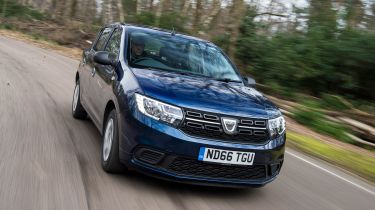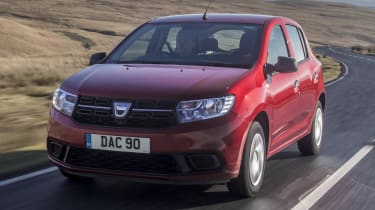Dacia Sandero (2013-2020) review - Engines, performance and drive
Dacia keeps things simple, so the Sandero comes with a choice of three engines and a manual gearbox. That’s it.

On the road, the Dacia Sandero doesn’t really do much wrong, although you’ll never really enjoy driving it. Despite its elderly Renault Clio underpinnings, the Sandero rides well and has decent grip. However, kickback through steering, limp gearshift and poorer refinement betray the car’s nineties mechanical roots.
Still, the ride quality is really impressive. This is down to the relatively small wheels and high-profile tyres, and the fact that Dacia never set out to give the Sandero sporty responses.
Engines
When you read the story behind its development, you’d think all the Sandero has to offer is decade-old Renault tech that’s well past its sell by date. But that’s not quite the case. While the chassis is old, the 900cc TCe turbo three-cylinder is bang up to date. This is a thoroughly modern unit, essentially designed by Renault to replace the old 1.2 in its more modern cars – you can find it in service in the likes of the Clio and Captur. In the Sandero it produces 89bhp and offers reasonable acceleration, with 0-62mph reached in 11.1 seconds
It’s a lightweight, hi-tech engine with advances such as a light-pressure turbo and multipoint fuel injection. And in use it revs freely and is very willing, not to mention more refined than the entry-level engine. Mind you, that refinement from under the bonnet does show up how noisy the Sandero is in other areas, with tyre roar and wind noise letting the side down. Power delivery could be smoother, but it revs eagerly, pulls strongly and emits a characterfully thrummy soundtrack.
The basic 1.0-litre petrol engine needs working hard, although it's just about acceptable as long as you don’t ask too much of it. For those who buy Sanderos for short journeys, or just bumbling around town, its 74bhp output will be fine, but start extending it on motorways or main roads, and you’ll soon find that it struggles to keep pace with traffic.
The 1.5 Blue dCi diesel is no longer available, instead Dacia has added the 1.0-litre TCe 100 Bi-Fuel to the lineup. This is a dual-fuel petrol and LPG engine producing 99bhp and 160Nm of torque, with drivers able to switch between the two fuels at the touch of a button on the dashboard.
Dacia claims that the new engine will deliver enhanced performance due to more torque and reduced fuel costs for customers - while also delivering lower emissions.









